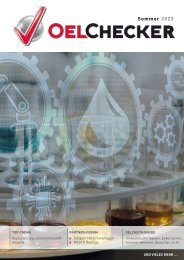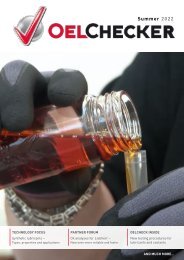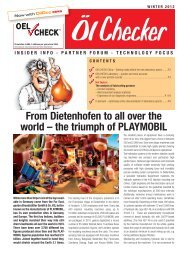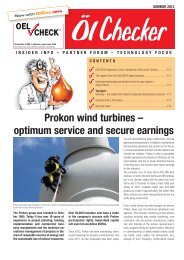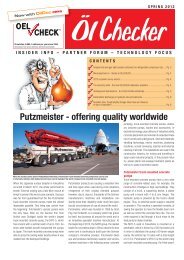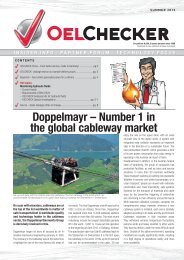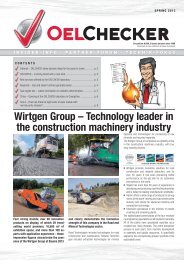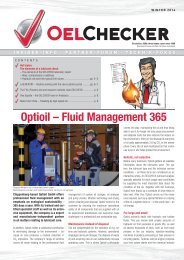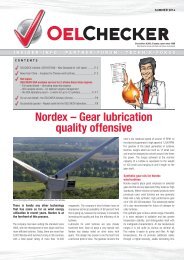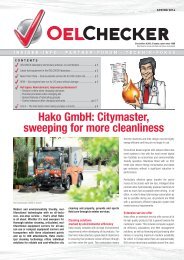OELCHECKER - Sommer 2020
> Check-up – OELCHECK is systemically relevant for maintenance > OELCHECK Inside: App with new features – OELCHECK 4.0 Data security – Awareness of digital risks Impressive visit to a paper factory OELCHECK is involved in innovative funding projects For the health of our employees Moving into the new OELCHECK building at the end of 2020 > OELCHECK Partner Forum: TEDOM SCHNELL combined heat and power plants – More value from energy > Technology Focus: Alternative fuels – Types and their characteristics > Q&A: Lubricants with a changed base oil – Effects
> Check-up – OELCHECK is systemically relevant for maintenance
> OELCHECK Inside:
App with new features – OELCHECK 4.0
Data security – Awareness of digital risks
Impressive visit to a paper factory
OELCHECK is involved in innovative funding projects
For the health of our employees
Moving into the new OELCHECK building at the end of 2020
> OELCHECK Partner Forum:
TEDOM SCHNELL combined heat and power plants – More value from energy
> Technology Focus: Alternative fuels – Types and their characteristics
> Q&A: Lubricants with a changed base oil – Effects
You also want an ePaper? Increase the reach of your titles
YUMPU automatically turns print PDFs into web optimized ePapers that Google loves.
Summer <strong>2020</strong><br />
INSIDER INFO PARTNER FORUM TECHNOLOGY FOCUS<br />
CONTENTS<br />
■ Check-up – OELCHECK is systemically relevant for maintenance ................................................................................ 3<br />
■ OELCHECK Inside:<br />
– App with new features – OELCHECK 4.0 ................................................................................................................ 4<br />
– Data security – Awareness of digital risks ............................................................................................................... 4<br />
– Impressive visit to a paper factory ........................................................................................................................... 4<br />
– OELCHECK is involved in innovative funding projects .............................................................................................. 5<br />
– For the health of our employees ............................................................................................................................. 11<br />
– Moving into the new OELCHECK building at the end of <strong>2020</strong> ................................................................................. 11<br />
■ OELCHECK Partner Forum: – TEDOM SCHNELL combined heat and power plants – More value from energy 6-7<br />
...................................................................................................................................................................................<br />
■ Technical focus<br />
: – Alternative fuels – Types and their characteristics ............................................................................................ 8-10<br />
■ Q&A: Lubricants with a changed base oil – Effects ................................................................................................p. 12<br />
Turning logistics green –<br />
Johann Dettendorfer Spedition<br />
Perfect logistics for Industry 4.0<br />
Johann Dettendorfer Spedition is one of the top 100<br />
German logistics companies. Many international<br />
awards attest to the achievements of this traditional,<br />
owner-managed company. Its headquarters<br />
are in Inntal, Bavaria, directly on one of Europe's<br />
major north-south axes. There are further locations<br />
in Italy, Poland and several German federal states.<br />
On the road in Europe with biodiesel – Johann Dettendorfer Spedition trucks.<br />
The trucks of Johann Dettendorfer Spedition<br />
Ferntrans GmbH & Co. KG transport the<br />
goods entrusted to them to their destination<br />
flexibly, quickly, reliably and safely. Every<br />
year they cover millions of kilometres on the<br />
roads of Europe. But the environmental impact<br />
is as low as possible, because Johann<br />
Dettendorfer Spedition has been running its<br />
entire fleet on biodiesel (B100) since 1998.<br />
This reduces carbon emissions by over 60%<br />
compared to diesel from petroleum. The vegetable<br />
raw materials for biodiesel, such as<br />
rapeseed, consume CO 2<br />
as they grow. This<br />
is neutralised and the carbon footprint when<br />
using biodiesel is balanced.<br />
However, almost all truck manufacturers still require<br />
very short engine oil changes when running<br />
on biodiesel. Old findings relating to running engines<br />
on rapeseed oil, which at the time was still<br />
pure and not esterified, indicate that when using<br />
B100 engine oils should be changed after one-third<br />
of the usual mileage (usually 30,000km instead of<br />
100,000-120,000km). But are the arguments in<br />
favour of short oil usage periods valid? Could the<br />
lubricants be used longer? OELCHECK gets to the<br />
bottom of these questions and closely monitors the<br />
used engine oils from the B100-powered vehicles<br />
at Johann Dettendorfer Spedition.<br />
Johann Dettendorfer Spedition was founded in<br />
1825. Today, the core competencies of the company<br />
include comprehensive warehousing and logistics<br />
services in addition to goods transport. The trend<br />
is increasingly towards integrated service solutions.<br />
Johann Dettendorfer Spedition’s customers benefit<br />
from the company’s expertise, innovation, modern<br />
fleet and intelligent IT concepts. These perfectly<br />
meet the requirements of Industry 4.0, with its ITfocused<br />
way of working. This ensures deliveries to<br />
customers are not only just-in-time, but also justin-sequence.<br />
The Dettendorfer branch at Deizisau<br />
in Baden-Württemberg, for example, delivers liquid<br />
aluminium to the processing plant at the specified<br />
time and in the appropriate quantity at a temperature<br />
of 700 °C using special trucks. Transporting<br />
and storing raw materials and disposing of foundry<br />
waste are also part of the freight forwarder's service<br />
package.
2<br />
Carbon emissions reduced by over 60 %<br />
The aim is to operate the fleet economically and ecologically.<br />
Management has been demonstrating for<br />
years how well these aspects, which at first glance<br />
might seem contradictory, can be reconciled:<br />
• all vehicles in the large fleet are less than five<br />
years old and therefore state-of-the-art.<br />
• As much transport as possible is switched from<br />
road to rail.<br />
• The drivers of the trucks regularly take training<br />
courses on energy-efficient driving.<br />
• Since 1998, all vehicles have been powered by<br />
biodiesel. This reduces carbon emissions by over<br />
60 %!<br />
Biodiesel or FAME (fatty acid methyl ester) can<br />
be used in pure form (B 100) in diesel engines if<br />
approved by the vehicle manufacturer. The fuel<br />
consists of re-esterified vegetable oils.<br />
In Germany, it is almost exclusively based on rapeseed<br />
oil. Hence it is also called RME (rapeseed<br />
methyl ester). DIN EN 14214 sets out the minimum<br />
requirements for biodiesel. However, the<br />
freight forwarder’s specifications go far beyond<br />
this. For example, the total contamination of the<br />
fuel may only be 10 mg/kg instead of the 24 mg/<br />
kg required by the DIN standard. And instead of<br />
a maximum water content of 500 mg/kg, Dettendorfer<br />
only accepts 250 mg/kg. After all, water not<br />
only causes corrosion and wear and tear; excess<br />
water content also makes biodiesel susceptible to<br />
microbial growth.<br />
Since biodiesel ceased to enjoy favourable tax<br />
treatment in Germany in 2008, filling stations in<br />
Germany have become rare. Abroad, however, it is<br />
still cheaper than obtaining fossil diesel fuel from<br />
petroleum. This is clearly reflected in the operating<br />
costs of the fleet. After all, the tank of a large truck<br />
can hold up to 1,300 litres of fuel. As far as possible,<br />
refuelling takes place at one of the company's<br />
own truck stops in nearby Austria, thereby benefiting<br />
from favourable tax treatment.<br />
However the quality of the RME, which is monitored<br />
by OELCHECK taking random samples, has to<br />
meet the high requirements of Johann Dettendorfer<br />
Spedition. All other customers who fill up while<br />
travelling in their environmentally friendly trucks<br />
or cars also benefit from this. The Dettendorfer<br />
Group's Austrian truck filling station on the A12 in<br />
Inntal, Austria, is particularly popular with truckers.<br />
The free Truck Checkpoint is located here. Total<br />
weight and axle load are checked and tyre pressure<br />
and tread depth measured in just 15 seconds.<br />
These are important criteria that affect truck road<br />
safety as well as reducing fuel consumption and<br />
carbon emissions.<br />
Removing oil from a long-haul truck<br />
Shorter oil-change intervals –<br />
prevention or necessity?<br />
Johann Dettendorfer Spedition's vehicles are powered<br />
by pure biodiesel. This brings economic and,<br />
above all, ecological advantages. But there is also<br />
a drawback: most vehicle manufacturers recommend<br />
engine oil changes after 30,000 km rather<br />
than 100,000 km when trucks run on biodiesel.<br />
And this not does not just mean considerable additional<br />
costs! The engine of a single 40-ton truck<br />
uses approximately 40 litres of engine oil. Changing<br />
the oil and oil filter takes about two hours, and<br />
the vehicle is not available during this period. In addition,<br />
significantly more fresh oil is consumed and<br />
correspondingly more waste oil is produced. The<br />
total cost of an oil change is about 500 €, which<br />
eats up a large part of the fuel costs saved again.<br />
This high consumption of engine oil goes against the<br />
philosophy of Johann Dettendorfer Spedition, which<br />
is to use all resources sparingly. However, engines<br />
are also supposed to be operated safely and sustainably<br />
and achieve the longest possible service life.<br />
This is why engine oil is replaced after a short period<br />
of 30,000 km, in line with the specifications of MAN.<br />
Risk: increased fuel entrainment<br />
Specification of shorter oil-change intervals is<br />
based on past experience. It has been more than<br />
10 years since it was discovered that using the biodiesel<br />
quality available at the time led to increased<br />
entrainment of fuel into the engine oil. At the time,<br />
laboratory tests were only carried out on engines<br />
for agricultural vehicles fitted with the engine technology<br />
of that period. Unfortunately, there are no<br />
more recent long-term studies into the condition<br />
of used engine oils from commercial vehicles with<br />
a modern generation of engines and using more<br />
refined biodiesel.<br />
In general, for both biodiesel and fossil fuels, viscosity<br />
decreases if too much fuel penetrates an engine oil.<br />
The engine oil becomes thinner, lubrication performance<br />
decreases and there is a risk of engine wear.<br />
If biodiesel is used, this oil dilution may occur to a<br />
greater extent because the fuel does not burn completely.<br />
This is due to the physical properties of the<br />
fuel. Fossil diesel has a flash point of 55 °C or slightly<br />
higher, but the flash point of biodiesel is usually well<br />
above 100 °C. The permissible minimum under DIN<br />
EN 14214 is 101°C. Conventional diesel in engine<br />
oil evaporates at an oil temperature of roughly 80 °C,<br />
whereas biodiesel only does so to a limited extent.<br />
Uncombusted biodiesel can make the engine oil increasingly<br />
thinner. The risk of engine damage increases<br />
accordingly. If too much biodiesel is left in the engine<br />
oil, some of its incompletely esterified components<br />
can lead to greasy or even solid deposits in piston ring<br />
grooves or on the piston head and shorten the engine<br />
service life.<br />
Unfortunately, OEMs do not specify a maximum<br />
value for the proportion of biodiesel in engine oil.<br />
OELCHECK regards entrainment of over 6 % as critical<br />
for modern SAE 5W-30 low-friction diesel oils.<br />
This figure is based on the large number of used oil<br />
analyses from newer vehicle engines operated with<br />
biodiesel B7, B10 or B100.<br />
Engine oils closely monitored<br />
Are the shortened oil service life times prescribed<br />
by almost all vehicle manufacturers pure prevention<br />
or real necessity? Johann Dettendorfer Spedition<br />
started a preliminary study together with<br />
OELCHECK to find out more about the condition<br />
and performance of engine oils.<br />
OELCHECK has been monitoring the engine oils of<br />
three vehicles belonging to the freight forwarder since<br />
spring <strong>2020</strong>. In order to take into account as many<br />
operating conditions as possible, OELCHECK is examining<br />
the oils from a long-haul truck that operates<br />
on a two-shift system, a silo vehicle with a compressor<br />
and a truck used for regional transport. The engines<br />
use SAE class 5W-30 low-SAPS engine oil approved<br />
by the vehicle manufacturer. This has a synthetic base<br />
oil, meets international specifications and is approved<br />
for use in EURO V and VI engines by all well-known<br />
vehicle manufacturers.<br />
continued on page 5 ...
OELCHECK CHECK-UP<br />
The Coronavirus crisis revealed that OELCHECK<br />
s systemically important for maintenance<br />
A small virus keeps the big world in check. In spring <strong>2020</strong>, the politically ordered lockdown and its economic consequences<br />
came on top of the threat to health. Short-time working or furlough affected the majority of the population. But in sectors<br />
that ensure the supply of everyday commodities, medical technology, electricity and water, work continued uninterrupted.<br />
Technical maintenance in companies was usually still fully operational, even if production was halted. The aim was to ensure<br />
that everything would run smoothly when work was resumed. Some plants had to operate at different capacity or shut down<br />
altogether. Many technical service companies faced new challenges. Often, remote diagnoses or web meetings supported<br />
the work of the plant engineers, because discussions on site were frequently not possible due to distancing regulations, for<br />
example. OELCHECK's analyses of lubricants and fuels also contributed to the operational safety of machines and engines,<br />
ensuring systems and machinery operated reliably.<br />
No lockdown at OELCHECK<br />
OELCHECK remained active as usual during the critical period, even though many globally active competitor laboratories shut down completely. Action plans<br />
were prepared at the first signs of the pandemic. From 19 March, work was changed to a two-shift system, so laboratory reports were available to our<br />
customers in the usual 24-hour rhythm. Since the number of samples did not decline as first feared due to coronavirus but actually increased, every single<br />
OELCHECK employee had to show flexibility and commitment. OELCHECK considers itself fortunate to employ staff who were willing to work on Saturdays.<br />
Employees were pleased that despite being present for only six hours instead of eight, they continued to receive their full salary without having to register<br />
for short-time working. It is important for customers to receive timely information to ensure that their production-relevant machines continue to run reliably.<br />
OELCHECK tribologists took the changed operating conditions due to the crisis into account in their recommendations. But despite all the difficulties, all<br />
OELCHECK laboratory reports are being delivered within one day as usual and all special customer questions are being answered.<br />
Safety thanks to OELCHECK analyses<br />
Particularly in difficult times, OELCHECK analyses support customers in determining the optimal time for an oil change and detecting any worn components<br />
early. If an oil change is carried out too late, this can result in a total failure of the lubricated component.<br />
A typical example is the gas engines used in CHP plants. They often run not only on clean natural gas, but also on biogas, which can vary greatly in quality<br />
depending on its composition. This places considerable demands on the gas engine oil, which has acidic components that have to be neutralised, for<br />
example. If its alkaline reserves are exhausted, aggressive acids can directly damage engine components or seals. To detect this, regular oil analyses are<br />
an absolute must. Because if the engine needs to be repaired or overhauled, neither electricity nor heat can be generated. During the coronavirus crisis,<br />
OELCHECK made an increased contribution to safeguarding the operation of wind turbines, power plants, gas engines and other energy production systems.<br />
This made it crystal clear: OELCHECK is systemically relevant for the maintenance of power generation systems.<br />
OELCHECK leading the way in digitalisation<br />
Many politicians and media claim that the coronavirus crisis will give added momentum to digitalisation. What may be the case for some companies in the<br />
future has long been part of everyday life at OELCHECK. In recent weeks in particular, our customers have increasingly benefited from the advantages of our<br />
digital services.<br />
The free OELCHECK 4.0 app offers our customers an easy way to enter sample data for trend-analyses. Customer-specific details and information on the individual<br />
units from which the samples originate are entered only once. The OELCHECK customer portal www.LAB.REPORT is extremely practical because it<br />
contains many control and management processes. All it takes to log in to the OELCHECK world of digital data is your personal password.<br />
Simple handling, clearly explained<br />
The coronavirus crisis was no reason for oil samples not to be taken when due. Our all-inclusive analysis kits contain everything you need for uncomplicated<br />
sample removal and shipping. Easy-to-understand instructions for optimal sampling are enclosed with the shipping box or are available at www.oelcheck.de.<br />
With the aid of the sample vial, the information form and the return envelope, samples can be taken immediately even by an inexperienced person who may<br />
be standing in for the usual service technician.<br />
OELCHECK returned to normal operation under the strictest hygiene conditions and without short-time working on 1 June <strong>2020</strong>. All employees and visitors<br />
are obliged to strictly adhere to the hygiene and health protection standards set by the RKI and the Federal Ministry of Health in order to minimise the risk<br />
of infection at the company as far as possible. The coronavirus pandemic and its consequences present us all with extraordinary challenges. Even in this<br />
difficult situation, while complying with the necessary safety measures, we are working hard to provide our services and customer care to the usual quality.<br />
Barbara Weismann, Paul Weismann<br />
3
OELCHECK INSIDE<br />
OELCHECK 4.0 – data entry for new<br />
samples has never been easier ...<br />
Every sample we analyse and diagnose is only<br />
complete with the information on the service/lubricant<br />
and the machine in which it is used. An app is<br />
available to our customers for entering the sample<br />
data. The first version was launched in 2016 – now<br />
the new, improved version of the sample data entry<br />
app has been released: OELCHECK 4.0.<br />
With the expansion of the app, additional features<br />
have been added to make entering oil samples<br />
even more user-friendly. The new functions are all<br />
available in the free login area. In addition to entering<br />
data on the sample, up to five photos of the<br />
sample can now be added – taken with the app.<br />
The last laboratory report for the sample entered<br />
with the device can also be accessed. And thanks<br />
to the automatic data update, users always have<br />
an overview of the current status of their samples.<br />
The app functionality has also been expanded to<br />
include offline features: data on lubricant and fuel<br />
samples can now also be entered offline and transferred<br />
later. A valuable addition, because you can’t<br />
always rely on mobile internet.<br />
Using the app<br />
A QR-code is required to use the app. This can be<br />
printed out yourself via our customer portal<br />
LAB.REPORT or requested directly from us.<br />
The QR code is then attached to the installation<br />
or machine. If a new sample is to be entered, the<br />
user scans the QR code with their smartphone and<br />
selects the appropriate system component. The<br />
app automatically recognises the installation and<br />
component and specifies the next steps.<br />
All you need to do is add the sample-related data<br />
that change with each sample – no sample information<br />
form, pen or paper are required.<br />
Sample entry has never been so fast and easy.<br />
OELCHECK 4.0 is available for Android and iOS<br />
in German and English. Using the app is free of<br />
charge.<br />
Data security: Awareness of digital risks<br />
Many companies underestimate digital risks.<br />
OELCHECK is aware of its responsibility and has<br />
therefore introduced comprehensive cyber crisis<br />
management. Should a digital attack occur, a predefined<br />
crisis team swings into action. This group<br />
has been trained with the support of an external<br />
service provider. The IT security company also provides<br />
preventive support during the crisis and in a<br />
subsequent security analysis to quickly identify and<br />
close potential weak points.<br />
OELCHECK employees have received online training<br />
on phishing, social engineering as well as<br />
password and workplace security. Questions such<br />
as “What is a strong password?” and “Why is it important<br />
that your password is not in the dictionary?”<br />
were discussed and answered in great detail.<br />
Attackers can also steal data from an office that<br />
is supposedly secure. Small steps that can significantly<br />
increase data security in everyday life were<br />
also discussed as part of the online training. After<br />
the training, each employee also had to take a<br />
small test.<br />
The online training has helped raise awareness of<br />
what cyber attacks can look like and how everyone<br />
can contribute to IT security.<br />
Impressive visit to paper mill<br />
During a detailed and comprehensive plant tour at<br />
Raubling Papier GmbH (Heinzel), OELCHECK employees<br />
were able to get an idea of the conditions<br />
under which the paper machines are used on a<br />
daily basis. The machines run around the clock –<br />
in an enclosure at up to 80 °C and up to 90 %<br />
humidity. Every year, around 220,000 tonnes of<br />
certified special corrugated paper with a width of<br />
2.5 m are produced on two paper machines. The<br />
demands placed on the machines are correspondingly<br />
high.<br />
The company was acquired by PWA (Papierwerke<br />
Waldhof-Aschaffenburg) in 2004 and has been<br />
gradually modernised and reorganised ever since.<br />
What was a purely wood processing paper mill with<br />
a tradition dating back more than 100 years has<br />
became a forward-looking location mainly focused<br />
on processing recycled paper.<br />
The impressive insights into the overall production<br />
processes made it clear that oil analyses in the<br />
paper machines sector are absolutely necessary<br />
and appropriate. The entire production process<br />
grinds to a halt if the paper machine oil used for<br />
lubrication in the oil circulation system no longer<br />
does its job reliably in the bearings and gears.<br />
4
continued from page 3 ...<br />
The engine oils from the three vehicles are closely<br />
monitored. Apart from biodiesel entrainment, the<br />
general oil condition, wear elements, dust, water<br />
and other impurities, additive degradation and<br />
oil oxidation are examined. An initial sample was<br />
taken after approx. 30,000km when the oil was<br />
changed. The fresh oil and the sample were then<br />
examined immediately after the oil change. Further<br />
analyses are carried out every 5,000km.<br />
An initial conclusion<br />
The results of several analyses from the series of<br />
tests are now available. Mileage of up to 30,000km<br />
was achieved by the end of May <strong>2020</strong>. The wear<br />
values are extremely low. The feared increased<br />
entrainment of biodiesel into the engine oils did not<br />
occur. A maximum of 1.3 % biodiesel was detected<br />
in the engine oil of the long-haul truck and 2.1 % in<br />
the silo vehicle. The engine oil from the short-haul<br />
truck showed contamination with 2.3-3 % biodiesel.<br />
Since operating temperatures of over 60 °C<br />
are hardly reached in this truck, OELCHECK had<br />
actually forecast slightly higher values.<br />
The preliminary study has not yet been completed.<br />
However, the results so far clearly indicate that<br />
oil-change intervals could be extended well over<br />
30,000 km; this will be examined in detail as part<br />
of a development project. The trend is absolutely<br />
positive. Close monitoring of the engine oils with<br />
OELCHECK analyses continues.<br />
Flexible, fast, reliable, safe<br />
Johann Dettendorfer Spedition’s comprehensive<br />
service in transport, logistics and<br />
merchandise management can be relied on.<br />
Founded in 1825, the owner-managed traditional<br />
company is now one of the top 100 in<br />
German logistics. Almost 400 highly motivated<br />
employees work at the company. The fleet<br />
comprises 145 tractor units and 350 trailers<br />
for long-haul transport alone. The company’s<br />
turnover in 2019 was around 220 million<br />
euros. Johann Dettendorfer Spedition is ISO<br />
DIN EN ISO 9001:2015 certified. Their firstclass<br />
credit ratings from BUNS, Bürgel and<br />
Creditreform speak for themselves.<br />
More information: www.dettendorfer.de<br />
OELCHECK is involved in innovative funding projects<br />
The Federal Ministry for Economic<br />
Affairs (BMWi) supports innovative<br />
projects with targeted funding programmes.<br />
OELCHECK too is active in<br />
research and development and is currently<br />
involved in three funding projects.<br />
Start of µ-Spin in 2014<br />
As part of a first funding project six years ago,<br />
OELCHECK began its cooperation with OTH Regensburg<br />
and the University of Regensburg. Project<br />
µ-Spin was then launched together with other<br />
partners (Starkstrom-Gerätebau GmbH and Maschinenfabrik<br />
Reinhausen GmbH), with the aim of<br />
developing a new type of sensor based on surface<br />
plasmon resonance spectroscopy for insulating oils<br />
that enables permanent monitoring of technical<br />
fluids using “surface plasmon resonance imaging<br />
(SPR-i)” technology. This should make it possible<br />
to extend service life and increase energy efficiency.<br />
Basic investigations of the lubricating oil were<br />
carried out and two types of insulating oil were<br />
specifically contaminated during tests and then<br />
measured in order to be able to show the changes<br />
in the analysis .<br />
The follow-up project MicroSpinII (which started<br />
in November 2019) is now aiming to bring<br />
the sensor to application maturity with the help of<br />
new industrial partners (OTH Regensburg, University<br />
of Regensburg, Deggendorf Institute of Technology,<br />
Starkstrom-Gerätebau GmbH, GEFASOFT<br />
GmbH, TOPTICA Photonics AG, Solnovis GmbH,<br />
University of Regensburg, FUCHS Schmierstoffe<br />
GmbH and Messko GmbH). Doping of the sensor<br />
surface will be realised in contact with the oil to be<br />
measured and subject to the measurable changes<br />
depending on the degree of ageing. The focus is on<br />
the degradation of ageing inhibitors and oxidative<br />
degradation of the base oil, with the formation of<br />
the respective breakdown products. At the same<br />
time, the corresponding oils will be examined at<br />
OELCHECK in order to correlate the data obtained<br />
by the sensor. Multivariate evaluation algorithms<br />
will then be generated in order to be able to show<br />
the changes in the oil in real time.<br />
The sensor is a wafer-thin gold surface with<br />
micrometer-sized holes that changes a light beam<br />
depending on the surrounding medium (i.e. the oil)<br />
Need for dedicated analytical methods<br />
for e-mobility gear oils<br />
Since April 2019, OELCHECK has been involved<br />
in a project funded by ZIM (the Central Innovation<br />
Programme for SMEs) focusing on “developing a<br />
methodology for analysing and characterising e-<br />
mobility lubricants”. The cooperation partner is the<br />
Karlsruhe Institute of Technology (KIT).<br />
The automotive industry is facing enormous<br />
changes. Alternative drive forms are entering the<br />
market. The requirements for lubricants for electronic<br />
final drives have changed and mean that the<br />
scope of analysis has to be adjusted – for fresh oil<br />
and for the quality inspection of used lubricants.<br />
Nuclear magnetic resonance, a method OELCHECK<br />
has already further developed with KIT for analytical<br />
characterisation of oils, is suitable for this.<br />
The NMR method for quality assessment will now<br />
be expanded and tested as an application for the<br />
newly developed material systems of e-mobility<br />
oils. To begin with, the knowledge of lubricants<br />
intended for electric drives will be analysed in order<br />
to identify possible ageing processes based on this.<br />
The intention is then to develop a basic system for<br />
analysing and evaluating known e-lubricants.<br />
OELCHECK would like to establish an efficient and<br />
cost-effective test that will provide a practicable<br />
basis for evaluation, such as the limit values for the<br />
ageing of e-mobility lubricants.<br />
New ZIM InfraOil project<br />
The new ZIM InfraOil project was launched in<br />
June <strong>2020</strong>. The aim of the project is to develop a<br />
near-infrared and an optional fluorescence sensor<br />
system for inline detection of signs of ageing or<br />
decomposition in hydraulic oils. This should enable<br />
continuous quality control and, if necessary, partial<br />
reconditioning of the oils.<br />
5
OELCHECK PARTNER FORUM<br />
TEDOM SCHNELL combined heat and power<br />
plants – More value from energy<br />
TEDOM SCHNELL's new passive prechamber is revolutionising<br />
the CHP technology of the future. The<br />
fuel-gas/air mixture is already ignited in the prechamber<br />
by a specially matched industrial spark plug.<br />
This results in an increase in pressure, which drives<br />
the ignited mixture far into the main combustion<br />
chamber in several torch jets. The result is fast<br />
and efficient combustion with low emissions. For<br />
robustness, reliability and long service life of the<br />
prechamber and spark plug, TEDOM SCHNELL’s<br />
new development is better than anything currently<br />
available on the market.<br />
TEDOM SCHNELL CHP solutions are based on future-oriented yet proven technologies.<br />
TEDOM SCHNELL GmbH, based in Wangen/Allgäu,<br />
is a manufacturer of combined<br />
heat and power plants (CHP) for<br />
decentralised generation of electricity<br />
and heat. The highly efficient CHP solutions<br />
run on natural gas, biogas or sewage<br />
gas and function according to the<br />
principle of combined heat and power<br />
generation. Once the project has been<br />
planned and the facilities constructed,<br />
the company's own strong service fleet<br />
is available to operators around the<br />
clock.<br />
TEDOM SCHNELL has one of the largest service<br />
networks for CHP plants in Germany. OELCHECK<br />
analyses of gas engine oils and coolants optimise<br />
condition monitoring in the facilities. This ensures<br />
reliable and efficient energy supply in the long term.<br />
TEDOM SCHNELL CHP solutions utilise the full<br />
capacity of primary energy through highly efficient<br />
generation of electrical and thermal energy. The<br />
company's 4,100 CHPs already installed are used<br />
throughout Europe in biogas plants and landfills as<br />
well as for industrial, commercial and municipal<br />
energy supply. The different designs, such as compact<br />
modules, in containers or in a turbine building,<br />
are tailored to individual requirements.<br />
Pioneering technologies<br />
The company's technical developments are trendsetting.<br />
Previously it was the “Schnell dual fuel<br />
engine”, now it’s the “passive prechamber” that is<br />
setting new standards.<br />
The dual fuel engine is based on the diesel principle.<br />
But when operated with biogas, sewage gas or<br />
landfill gas, the dual fuel engine can do even more.<br />
Gases can be more compressed than diesel fuel,<br />
for example. The gas is mixed with the combustion<br />
air drawn in. The mixture of gas and oxygencontaining<br />
air is compressed in the engine and<br />
heats up in the process. Injecting a small amount<br />
of ignition oil (heating oil/diesel fuel) initiates the<br />
ignition. The higher compression ratio of the gasair<br />
mixture increases efficiency. Higher efficiency<br />
means higher energy yield. To achieve this, the<br />
intelligent Schnell injection technology for dual fuel<br />
engines was developed.<br />
Biogas, sewage gas and landfill gas often change<br />
their composition in a short time. Values such<br />
as knock resistance and flame rate can double or<br />
halve in seconds. These changing conditions are<br />
controlled with the Schnell dual fuel technology.<br />
This is based on sophisticated electronic injection<br />
technology for optimum control of ignition timing –<br />
a milestone in the history of dual fuel technology.<br />
Germany's largest service network<br />
TEDOM SCHNELL ensures that facilities operate<br />
without problems and profitably through a comprehensive<br />
range of services. This starts with the first<br />
consultation and does not stop at maintenance and<br />
repair. Over 300 service technicians and partners<br />
throughout Europe are available around the clock.<br />
These are all fully trained and certified. TEDOM<br />
SCHNELL operates one of the largest service networks<br />
for CHP plants in Germany, and it is continuously<br />
being expanded with new service locations.<br />
Europe-wide service around the clock<br />
Tailor-made lubricants<br />
TEDOM SCHNELL knows how crucial lubricants<br />
and coolants are for systems to run safely and<br />
efficiently. The company therefore offers its own<br />
tailor-made consumables. These were developed<br />
with TEDOM SCHNELL’s many years of experience<br />
in gas engines and the expertise of renowned lubricant<br />
manufacturers.<br />
TEDOM SCHNELL PROTECT OIL is recommended<br />
for all CHPs installed by the company. Thanks to its<br />
selected base oils and unique high-performance<br />
additives, it achieves the highest level of wear protection<br />
and stability even under the toughest opera-<br />
6
ting conditions. Its extremely low tendency to form<br />
deposits means engines remain clean. TEDOM<br />
SCHNELL PROTECT OIL has a very large alkaline<br />
reserve. This allows it to neutralise the typical<br />
aggressive acids from biogas, sewage gas<br />
and landfill gas over a particularly long period<br />
of time. The gas engine oil is extremely resi-<br />
stant to thermal oxidation and is therefore also<br />
ideal for use in CHP plants running on natural gas,<br />
which operate at extremely high temperatures.<br />
TEDOM SCHNELL PROTECT COOLANT is a readymix<br />
coolant for engines. The preprepared mixture<br />
can be used immediately. This means that operators<br />
are always on the safe side and save time and<br />
money. The coolant is precisely matched to the<br />
materials of engine and attachments. Thanks to<br />
the ideal mixing ratio, the anti-corrosion and buffer<br />
additives are used optimally and the components<br />
are protected over the long term. The decalcified<br />
and extremely soft make-up water prevents the<br />
formation of encrusted deposits and the damage<br />
these cause.<br />
Oil analyses right from the start<br />
Regular inspections of the gas engine oil are<br />
important. Right from the purchase of a system,<br />
TEDOM SCHNELL offers a certain number of free<br />
OELCHECK oil analyses and inexpensive follow-up<br />
analyses. Engines that run on biogas, sewage gas<br />
or landfill gas in particular are using a gas where<br />
the composition can vary greatly. Such gases also<br />
often contain aggressive or acidic components<br />
such as hydrogen sulphide.<br />
TEDOM SCHNELL PROTECT OIL is perfectly designed<br />
to meet such requirements but, depending<br />
on the gas composition, even its performance is<br />
eventually exhausted under these extreme loads.<br />
Two to four OELCHECK analyses are carried out for<br />
every engine oil fill per year and also at every maintenance.<br />
These meticulously record the condition<br />
of the gas engine oil. OELCHECK tribologists also<br />
state in their laboratory reports how long the oil in<br />
question can still be used safely under similar operating<br />
conditions. Monitored in this way, in many<br />
cases TEDOM SCHNELL PROTECT OIL achieves<br />
oil change intervals of almost 1,000 hours of operation.<br />
Without accompanying oil analyses, TEDOM<br />
SCHNELL stipulates oil changes after 600 operating<br />
hours.<br />
Two at once – T E D O M<br />
SCHNELL lists the OELCHECK<br />
all-inclusive kits for gas engines in its own<br />
spare parts programme. This enables the analysis<br />
of engine oils, regardless of the gas they run on,<br />
and of coolants. Like many other OEMs, TEDOM<br />
SCHNELL specifies that coolant must be examined<br />
once a year. If OELCHECK analyses are consistently<br />
good, the coolant change interval can often be<br />
extended to two years.<br />
The all-inclusive analysis kit with a turquoisecoloured<br />
lid covers the full check scope. For each<br />
analysis, the acid-base content of the oil in particular<br />
is checked. The acid number (AN) indicates the<br />
degree of acidification of the oil. The base number<br />
(BN) provides information on the base additives<br />
still present to neutralise the acids. OELCHECK<br />
also measures the i-pH value, as this provides key<br />
additional information on the loading of a used gas<br />
engine oil with corrosive acids.<br />
Fast and secure – Thanks to the OELCHECK app<br />
4.0 and QR codes attached to equipment, operators<br />
and TEDOM SCHNELL service technicians<br />
now save even more valuable working time when<br />
entering samples and transmitting data. They only<br />
enter the operating hours of the current sample,<br />
add any information about work carried out and<br />
any abnormalities and scan the barcode on the<br />
sample information form, which is identical to<br />
the laboratory number they affixed to the sample<br />
container. The app then transmits the data to OEL-<br />
CHECK. The smart combination of QR codes and<br />
app means all important data is captured. Transmission<br />
errors due to poorly legible handwritten<br />
entries on the sample information forms are a thing<br />
of the past.<br />
Everything under control – The LAB.REPORT<br />
web portal is where the data from all analyses<br />
initiated by TEDOM SCHNELL and the plant operators<br />
(with corresponding approval in accordance<br />
with the GDPR) come together. This gives TEDOM<br />
SCHNELL a broad overview of all trends, contributing<br />
directly to perfect quality management. For<br />
plant operators, the web portal not only provides<br />
quick access and easy management of their analytical<br />
data. It also makes it easier to monitor the<br />
systems and document that the OELCHECK analyses<br />
recommended by TEDOM SCHNELL have been<br />
carried out regularly.<br />
A pioneer with innovative power<br />
Founded in 1992, the company has evolved<br />
from a German pioneer and market<br />
leader for dual fuel gensets to an international<br />
technology specialist that converts<br />
energy into performance, efficiency and<br />
yield. With CHP solutions based on future-oriented<br />
yet proven technologies. The<br />
company has already installed around<br />
4,100 CHPs across Europe. Service employees<br />
currently look after more than<br />
3,000 systems.<br />
TEDOM SCHNELL has been a member of<br />
the TEDOM Group since 2016. TEDOM is<br />
a globally active CHP manufacturer and<br />
CHP operator from the Czech Republic.<br />
The merger allows TEDOM SCHNELL<br />
to benefit quickly from many valuable<br />
synergies.<br />
More information: www.tedom-schnell.de<br />
7
OELCHECK TECHNOLOGY FOCUS<br />
Alternative fuels:<br />
Types and their characteristics<br />
It will be a long time before we are all travelling in electric cars or under hydrogen power. If Germany is to reach its ambitious<br />
goal of climate neutrality by 2050, alternative fuels will play an important role at least until then. Some of them are already<br />
widely used today in their pure form or as a mixture with fossil diesel and petrol fuels. Since 2007 the German Biofuel Quota Act<br />
(BioKraftQuG) has even stipulated a minimum share of biofuels as a percentage of total fuel sales in Germany.<br />
VEGETABLE OILS<br />
Production/<br />
base materials<br />
Availability<br />
Properties/<br />
standards<br />
• Pure oils pressed from plants, largely untreated.<br />
• Mostly rapeseed; also soya, corn and sunflowers.<br />
• Oils are pressed directly from the plants.<br />
They are also extracted from the remaining press cake with solvent.<br />
• This is followed by filtering and cleaning, which reduces solids and also components such as calcium, magnesium and<br />
phosphorus.<br />
• Not available at conventional filling stations.<br />
• Usually only available from the producer (farmer). Manageable logistics.<br />
• Vegetable oils are much more viscous (thicker) than diesel and are not suitable as a petrol substitute.<br />
• They are harder to ignite and deliver slightly less energy per litre than diesel.<br />
• They must be preheated in winter. Up to 10% fossil diesel is often added to improve viscosity and ignition characteristics.<br />
• DIN 51623 Fuels for vegetable oil compatible combustion engines.<br />
Use<br />
In tractor and agricultural machinery engines, in stationary CHP plants, rarely in truck engines.<br />
Engine/oil/<br />
analytics<br />
• Almost all types of diesel engines have to be “converted” (other seals, filters, injection system, etc.).<br />
• Manufacturer approval for running on vegetable oil should be available.<br />
• Operated with SAE 10W-40 engine oils - as for diesel engines.<br />
• Significantly reduced oil change intervals. Oil service life only 25-30% (up to about 250 hours) compared to using diesel.<br />
• Vegetable oil does not fully burn, especially when the engine is cold. Higher-viscosity components condense and contaminate<br />
the engine oil as uncombusted vegetable oil.<br />
• Engine oil may be mixed with a maximum of 5% vegetable oil. Otherwise there is a risk of piston ring sticking and deposits.<br />
• Oil analyses to determine vegetable oil content and oxidation characteristics are absolutely essential.<br />
BIODIESEL – FAME – RME<br />
Production/<br />
base materials<br />
Availability<br />
Properties/<br />
standards<br />
Use<br />
• Biodiesel is often referred to as fatty acid methyl ester (FAME) or RME (rapeseed methyl ester).<br />
• Based on oils and greases of vegetable or animal origin.<br />
These are “transesterified” into biodiesel in refineries specially designed for this purpose with the aid of methanol.<br />
• B100 (pure biodiesel with 100% biodiesel) is available at many truck filling stations and service stations as it can be transported<br />
in tankers without intermediate cleaning.<br />
• Only a few refineries specialise in production, so availability is not unlimited.<br />
• Also sold at special pumps as an admixture to diesel, where it is usually called B7 or, depending on the concentration, also<br />
B5, B10 or B15.<br />
• Slightly higher viscosity and lower cold stability than diesel.<br />
• Reduces mileage slightly, but is usually somewhat cheaper (mainly due to different taxation).<br />
• Largely carbon-neutral (up to 68%), as combustion only releases the amount of carbon dioxide that plants or animals remove<br />
from the atmosphere as they grow.<br />
• DIN EN 590 applies to B0 to B7 diesel; DIN EN 14214 applies to admixtures for B0 to B7 and B100.<br />
• B100 is often subject to additional quality requirements from operators for viscosity, combustibility, water content, cold stability,<br />
density and solid foreign substances.<br />
• Predominantly as a standard additive to fossil diesel (B7).<br />
• Also in pure form (B100) for truck use (freight forwarders, municipalities).<br />
8
Engine/oil/<br />
analytics<br />
BIOETHANOL<br />
Production/<br />
base materials<br />
Availability<br />
Properties/<br />
standards<br />
Use<br />
Engine/oil/<br />
analytics<br />
• No conversion of the diesel engines is required up to B10.<br />
• B100 should be approved by the engine manufacturer.<br />
• Mixed operation using B100 and diesel fuel is also usually possible without problems.<br />
Both types of fuel can be refuelled alternately, subject to OEM approval.<br />
• Any residues in the fuel system may be dissolved due to ester residues remaining in the RME/FAME (B100) from the refining<br />
process. Plastics, rubber and seals may also swell and non-ferrous metals in the fuel system can be attacked.<br />
• As a precautionary measure, replace the fuel filter more frequently. Perform accompanying fuel and engine oil analyses.<br />
• SAE 5W-30 to 10W-40 diesel engine oils approved by engine manufacturers can still be used.<br />
• When B100 is used, oil-change intervals in truck engine manufacturers’ specifications are often reduced to 30,000km<br />
instead of 120,000km.<br />
• Bioethanol, less commonly referred to as agro-ethanol, is made from residues of plants that still have residual sugar or starch<br />
content.<br />
• Alcohol is produced by fermenting these raw materials, which are usually not suitable for use in foodstuffs.<br />
• The starting materials are prepared as a mash to which yeast is added. The components result in a fermentation, which<br />
produces alcohol.<br />
• The alcohol content is then distilled from the fermented mass. The end-result is bioethanol with an alcohol content of up to<br />
99.9%.<br />
• Produced on a relatively large scale, but pure bioethanol is not freely available.<br />
• Bioethanol can be used in petrol engines. E10 super petrol at filling stations contains 10% bioethanol.<br />
• Bioethanol is unsuitable for addition to diesel fuel.<br />
• Pure bioethanol has a higher octane rating than petrol and a different ignition point.<br />
• Ethanol makes rubber (seals and hoses) and plastics softer or more brittle.<br />
• Unlike petrol, it does not vaporise at temperatures below 13°C (preheating may be necessary in winter).<br />
• DIN EN 228 permits the addition of ethanol to petrol in Germany up to 10% by volume (E10).<br />
• However, E10 must meet the quality requirements of DIN EN 15376 for super petrol.<br />
• Pure bioethanol or gasoline-ethanol mixtures containing more than 10% ethanol are no longer used as fuel.<br />
• Bioethanol is usually added to the petrol. In accordance with DIN EN 228, this may contain up to 5% bioethanol (E5) without<br />
it having to be declared.<br />
• A higher concentration of 10% admixture is possible in super petrol (E10), but this has to be declared.<br />
• Bioethanol is also often used as a basis for producing fuel additives.<br />
• For years, petrol engines have been able to operate without problems with E5 and E10.<br />
• All engine oils listed in vehicle manufacturers’ approval lists can be used.<br />
• E10 can increasingly condense in the engine oil at low engine temperatures in short-haul transport. Its viscosity and lubricity<br />
are reduced as a result, and wear and tear occurs.<br />
• An engine oil analysis in the OELCHECK laboratory clearly shows any mixing with unburned bioethanol.<br />
NATURAL GAS – CNG – COMPRESSED NATURAL GAS – PRESSURISED GAS<br />
Production/base<br />
materials<br />
Availability<br />
• Like petroleum, natural gas is produced from fossil components.<br />
• It is extracted from underground deposits and consists predominantly of highly flammable methane.<br />
• In some cases it has to be cleaned of corrosive, toxic and/or non-combustible foreign gases.<br />
• Water containing minerals is removed in a drying process.<br />
• For use as fuel it is compressed and stored or marketed in overpressure gas tanks.<br />
• Relatively well-developed filling station network.<br />
• Available at almost all motorway filling stations.<br />
Properties/<br />
standards<br />
Use<br />
• Natural gas burns cleanly without harmful hydrogen sulphide (no acid rain).<br />
• Neither nitrogen oxides, particulate matter nor soot are produced in any significant quantities.<br />
• The energy content of 1kg of natural gas is equal to that of 1.5l of petrol or 1.4l of diesel - hence it offers higher performance than<br />
other fuels.<br />
• The octane rating is 125 (petrol is roughly 95).<br />
• Due to the high knock resistance, the fuel-air mixture can be highly compressed. High efficiency is achieved with low<br />
consumption.<br />
• DIN EN 16723-2:2017-10 specifies natural gas for use in transport and biomethane for feeding into the natural gas network.<br />
• In principle, any petrol engine can be run on natural gas. Steel pressure tanks have to be installed.<br />
• Can also be used in buses or suitably designed new vehicles.<br />
• It is important to distinguish between bivalent vehicles that run on CNG and petrol, and monovalent vehicles that run purely on<br />
gas.<br />
• Internal combustion engines of vehicles powered by natural gas may also be used indoors (e.g. forklifts).<br />
• Natural gas-powered engines are used on a large scale for alternative generation of electrical energy, especially where waste<br />
heat can be used.<br />
9
Biogas in natural gas quality:<br />
• Biogas is produced by fermenting any kind of biomass. Its methane content is significantly lower than that of natural gas. It<br />
may contain a large proportion of carbon dioxide.<br />
• For biogas to be used like natural gas, it must be purified of harmful gases and its methane content increased to at least 96%.<br />
• Unpurified/unprocessed biogas can only be burned in specially designed engines (usually CHP).<br />
Engine/oil/<br />
analytics<br />
LNG (liquefied natural gas):<br />
• Natural gas becomes liquid when cooled to temperatures below -162°C. This reduces its volume by a factor of 600. Natural<br />
gas that has been liquefied by refrigeration compressors is called LNG. It is predominantly used in ships and special commercial<br />
vehicles.<br />
• Significantly higher combustion temperatures occur in gas-powered engines than in petrol engines. The engine and its oil are<br />
subjected to extreme thermal loads.<br />
• Unlike petrol, natural gas does not contain additives which have an active cleaning effect, among other things.<br />
• There is an increased tendency to oxidation, with the risk of ash containing hard deposits forming.<br />
• Engine manufacturers generally require the use of low/mid-SAPS engine oils, which have a limited sulphate ash content.<br />
• Some engine oils have been specially developed for natural gas and biogas engines.<br />
• Regular checks on the oxidation tendency and initial pH (i-pH) are recommended.<br />
LPG – LIQUEFIED PETROLEUM GAS – CAR GAS<br />
Production/base<br />
materials<br />
Availability<br />
• Liquefied petroleum gas is primarily obtained as a by-product when extracting natural gas and crude oil, and when distilling<br />
crude oil.<br />
• It may consist of propane, butane or a mixture of the two.<br />
• As a fossil fuel, it can also be used in petrol engines to generate energy.<br />
• Filling station network is very limited.<br />
Properties/<br />
standards<br />
Use<br />
Engine/oil/<br />
analytics<br />
• LPG is gaseous at ambient temperature and pressure. However, it can be liquefied at low pressure, usually 6 bar at room<br />
temperature. Once condensed, the volume is reduced by 260 times.<br />
• It has a high knock resistance of over 100 octane.<br />
• LPG burns almost sulphur-free, no soot is produced. Emission values are lower than those of petrol.<br />
• DIN EN 589 defines the quality requirements.<br />
• As fuel for petrol vehicles equipped with a gas tank for LPG operation. This is why it is also known as “autogas”.<br />
• Internal combustion engines powered by LPG or natural gas may also be used indoors (e.g. forklifts).<br />
• Also versatile use for heating, cooking or as a heat transfer medium in trade and industry.<br />
• The engine oil can become increasingly diluted by condensed LPG gas fractions, especially with many cold starts, such as in<br />
short-haul transport.<br />
• LPG, like natural gas, contains no additives or active cleaning agents such as are added to petrol.<br />
• The engine oil has to neutralise the oxidation products that arise when running on LPG, which lead to deposits.<br />
• Usually low-or mid-SAPS engine oils are used, which tend to have a low sulphate ash content.<br />
BTL – BIOMASS TO LIQUID – SYNTHETIC FUELS FROM BIOMASS<br />
Production/base<br />
materials<br />
• Raw materials are solid biomass (straw, wood, plant waste) or specially cultivated crops.<br />
• Thermochemical combustion of biomass produces synthesis gas.<br />
• This is converted into liquid hydrocarbons in a synthesis (usually using the Fischer-Tropsch process*).<br />
• The synthetic fuel produced can be converted into diesel or petrol by applying distillation processes used in petroleum refining.<br />
Availability<br />
Properties/<br />
standards<br />
Use<br />
Engine/oil/<br />
analytics<br />
• Not available in all countries.<br />
• Are added to conventional fuels.<br />
• BtL fuels are chemically only slightly different from fossil petrol or diesel fuels.<br />
• They usually have a higher cetane rating (around 70) than diesel (50-60).<br />
• Special properties can be tailored during distillation.<br />
• EN 15940:2016 Paraffinic fuels.<br />
• Currently not used in pure form.<br />
• DIN EN 228 or DIN EN 590 allow undeclared addition of BtL to specified petrol and diesel fuels.<br />
• No conversion of engines is necessary (also for exclusive use).<br />
• The products recommended by manufacturers can be used as engine oil.<br />
• Oil analysis depends on the load and mileage, as for operation with fossil fuels.<br />
10<br />
* Fischer-Tropsch synthesis: A large-scale process for converting synthesis gas (CO/H2) into liquid hydrocarbons developed by Franz Fischer and his employee Hans Tropsch<br />
at the Kaiser Wilhelm Institute for Coal Research in 1925. The process was previously mainly used for coal liquefaction by indirect hydrogenation of coal.
GTL – GAS TO LIQUIDS – SYNFUEL<br />
Production/<br />
base materials<br />
Availability<br />
• With the help of steam, adding pure oxygen to natural gas produces a synthesis gas.<br />
• Conversion to hydrocarbons takes place by means of Fischer-Tropsch synthesis*.<br />
• This produces long-chain paraffins that are converted into liquid fuels, primarily diesel, by cracking and distillation<br />
(fractionation).<br />
• Permanently available in many countries because gaseous natural gas is more difficult to transport and store than GTL.<br />
Properties/<br />
standards<br />
Use<br />
Engine/oil/<br />
analytics<br />
• Burns cleaner than fossil diesel and produces significantly fewer emissions.<br />
• Almost sulphur-free and contains no aromatic compounds.<br />
• Easier to ignite than fossil diesel (higher cetane rating).<br />
• Cold behaviour similar to fossil diesel.<br />
• EN15940:2016 standard for paraffinic diesel fuels.<br />
• Pure GTL is used in diesel engines on commercial vehicles or mobile machines and devices (construction machinery).<br />
• Low-emission inland waterway vessels are other major users.<br />
• GTL is added to diesel fuels such as Shell V-Power Diesel.<br />
• Leading diesel engine manufacturers have given approval for operation only with GTL.<br />
• No conversion of diesel engines necessary.<br />
• Engine oil analyses to monitor the oil change interval, as for operation with fossil diesel fuel.<br />
OELCHECK INSIDE<br />
For the health of our employees<br />
Motivated, satisfied and healthy employees are essential<br />
to the success of a company. That’s why we<br />
like to invest in the health of our employees. What<br />
really matters is continuously putting measures in<br />
place in a wide range of areas: the company medical<br />
officer Dr. Biller supports us in occupational<br />
health care and he is available to give advice on<br />
all questions relating to occupational health and<br />
safety.<br />
Our laboratory technicians were recently tested<br />
for residues of the hazardous substance toluene.<br />
All test results were below the detection limit. A<br />
reassuring and pleasing result.<br />
Our second Health Day was held in February<br />
in cooperation with health insurer KKH<br />
(Kaufmännische Krankenkasse) and focused<br />
on the spine and ergonomics, giving new encouragement<br />
for a healthy lifestyle. A basic check<br />
provided information on general health values.<br />
The advice on ergonomics concentrated on correct<br />
lifting and carrying. A posture analysis and<br />
the MFT Balance Board were available at further<br />
stations.<br />
A health barometer was carried out so future<br />
health promotion activities are better suited to employees’<br />
individual needs. By participating in the<br />
anonymous online survey, employees were able<br />
to play a key part in determining which screening<br />
offers and topics will be the focus in the future.<br />
The evaluation of the survey confirmed that there is<br />
interest in preventive health offers.<br />
Due to the coronavirus pandemic, the new prevention<br />
course originally planned cannot take place.<br />
But KKH offers an alternative with online coaches<br />
that allows our employees to do something for their<br />
health anytime and anywhere. The courses are<br />
quality-tested and recognised as certified prevention<br />
courses.<br />
The new building will be completed by the end of the year<br />
It all began in 1991 with premises in the railway<br />
station: this year the third and largest OELCHECK<br />
company building will be completed. There were<br />
delays during the coronavirus pandemic, but the<br />
new building is in the final phase –<br />
interior fitting out is now<br />
underway. The threestorey<br />
building covers<br />
approx. 2,000 m2 and<br />
will accommodate up<br />
to 50 employees. They can look forward to modern<br />
office workplaces and a generously designed cafeteria<br />
with eating and lounge area.<br />
A new and innovative corporate catering concept<br />
will be rolled out. The vision is to enrich daily work<br />
at the company with local ingredients, uncompromising<br />
freshness and skilfully prepared meals. Our<br />
employees can enjoy a healthy and individual lunch<br />
every day – freshly cooked by a chef. Eating together<br />
promotes a shared spirit and encourages communication<br />
and satisfaction. This is another reason<br />
why OELCHECK has newly created and already<br />
filled the position of Food & Beverage Manager. All<br />
catering offerings, quality assurance and operational<br />
processes in the kitchen and service sector are<br />
their responsibility.<br />
The entire move into Kerschelweg 18 will be completed<br />
by the end of the year. By then the management<br />
team, plus the tribology, sales, accounting<br />
and media design departments will be able to<br />
move into their new offices.<br />
11
For years we have always been using<br />
an oil from the same manufacturer<br />
with the same name and specification<br />
to lubricate our systems. It is regularly<br />
monitored with trend analyses. Oil<br />
changes are carried out on the basis of<br />
the suggestions of OELCHECK tribologists<br />
in the laboratory report. We have<br />
never noticed any abnormalities. However,<br />
the latest laboratory report now<br />
shows discrepancies under the heading<br />
“Additives” that do not fit with previous<br />
analyses or fresh oil. Do the changed<br />
values indicate a mixture of two different<br />
types of oil? What other reason<br />
could there be?<br />
OELCHECK:<br />
Almost all lubricants and hydraulic oils contain<br />
between 0.5% and 10% VI improvers, as well as<br />
oxidation inhibitors and organometallic additives.<br />
If additives are detected in an oil sample for the<br />
elements calcium, zinc, boron, phosphorus, barium<br />
or sulphur that were not found in previous<br />
studies or in another concentration, it is likely that<br />
different oil types have been mixed. Since other<br />
parameters such as viscosity or VI generally change<br />
in addition to the additive elements in a mixture,<br />
the oil manufacturer may have “upgraded”<br />
their product with another base oil without this<br />
being apparent from a change in the name or the<br />
specification sheet. Such a change usually also<br />
goes hand in hand with a slight adjustment of the<br />
additives.<br />
Since recently, a base oil that can be assigned to<br />
Group II has increasingly been used for mineral<br />
oil-based oils. Unlike Group I oils, which are only<br />
distilled with the aid of solvents, Group II base<br />
oils produced by hydrocracking have a higher VI<br />
and the proportion of saturated, oxidation-stable<br />
compounds is 90%. The sulphur content is also<br />
significantly lower. However, with the Group II<br />
oils produced on an increasingly large scale in<br />
modern refineries, there is no reduction in the<br />
performance of the end product or any quality<br />
impairment. Nevertheless, the formulation and<br />
additives must be adapted to the improved initial<br />
conditions.<br />
Base oils<br />
Mineral oil (Group II)<br />
Synthesis oil (ester, PAO)<br />
Rarely: pure vegetable oils<br />
Refinery<br />
Lubricant<br />
salesperson<br />
FAQ<br />
Summer <strong>2020</strong><br />
Base oils can be mineral or synthetic. The American<br />
Petroleum Institute (API) divides them into<br />
five groups:<br />
API BASE OIL CLASSIFICATIONS<br />
Formulierung von Schmierölen<br />
Drums,<br />
containers<br />
Formulated oil<br />
Base oil classifi cation Origin Sulphur<br />
content<br />
Group I (mineral oil)<br />
approx.<br />
1930<br />
The intended use and the requirements placed on<br />
the respective lubricant are what matters when<br />
selecting base oil types and additives.<br />
Mineral oil-based Group I base oils are the<br />
least changed during their production process,<br />
which is solvent refining. As pure base oils, they<br />
are usually only used for applications with relatively<br />
low technical requirements, such as recirculating,<br />
insulating or heat transfer oils.<br />
Mineral oil-based Group II base oils are usually<br />
produced using an elaborate hydrocracking process<br />
that removes impurities from the oil. Not only<br />
do they have a clearer colour, they also contain<br />
more than 90% saturated hydrocarbons. In addition,<br />
they contain less than 0.03% sulphur and mostly<br />
have a viscosity index of over 90. As a result,<br />
they have a significantly higher performance than<br />
Group I oils. They are chiefly distinguished by their<br />
better antioxidant properties and hence optimised<br />
ageing. This also means that less oxidation inhibitors<br />
or VI improvers need to be added to Group<br />
II-based oils.<br />
New lubricating oil refineries usually only produce<br />
Group II oils, because although production is more<br />
expensive than that of Group I, manufacturers of<br />
finished products can offset the additional costs<br />
PUBLISHER<br />
<strong>OELCHECKER</strong> – a magazine of OELCHECK GmbH<br />
Kerschelweg 28 · 83098 Brannenburg · Germany<br />
info@oelcheck.de · www.oelcheck.de<br />
All rights reserved. Reproduction is only permitted after<br />
receiving our approval.<br />
Concept and text:<br />
OELCHECK GmbH · Astrid Hackländer<br />
Layout and design:<br />
Agentur Segel Setzen, Petra Bots, www.segel-setzen.com<br />
Photos: TEDOM SCHNELL · J. Dettendorfer Spedition· Adobe<br />
Stock · OELCHECK<br />
Additives, admixtures<br />
Improve, suppress or improve<br />
the properties of the base oil<br />
Manufacturers of<br />
chemicals or additive packages<br />
Mixing tank with agitator or in-line blender<br />
Small<br />
packages<br />
Tanker truck<br />
by saving additives. With the current oversupply<br />
of Group II oils, cheaper purchase prices can be<br />
achieved. The use of Group II oils is predominantly<br />
price-neutral for the<br />
Saturated<br />
compounds<br />
Manufacture of lubricating and hydraulic oils<br />
Viscosity<br />
index<br />
usually > 0.03% usually > 90% 80-90<br />
Group II (mineral oil) 1971 max. 0.03% at least 90% 90-120<br />
Group III (mineral oil) 1993 max. 0.03% at least 90% min. 120<br />
Group IV (PAO synthesis oil) 1974 sulphur-free 100 % 125-200<br />
Group V (esters, glycols) 1940 unspecifi ed unspecifi ed unspecifi ed<br />
user and does not<br />
entail any technical<br />
disadvantages.<br />
Lubricant manufacturers are also not obliged to<br />
inform users of a base oil change by changing<br />
the product name or putting a note in the sales<br />
documents or data sheet. At OELCHECK, however,<br />
such changes stand out immediately due to a direct<br />
fresh oil comparison of the oil with the same<br />
name a few years ago and today. The additive<br />
changes caused by base oil are also evident in<br />
trend observations of machines in which only refills<br />
are carried out.<br />
If these permissible deviations do not result in any<br />
loss of quality, they will not be commented on in<br />
particular. Improved ageing stability can usually<br />
only be seen anyway by our tribologists in a direct<br />
fresh oil comparison with the help of the IR<br />
spectrum. The situation is different with defoamer<br />
additives containing silicon, which lead to lower<br />
silicon values at a lower additive concentration<br />
and thus give the impression that less siliconcontaining<br />
dust is in the oil.<br />
If the elements, the content of the additives or the<br />
IR spectrum suddenly no longer match fresh oil<br />
or previous trend, this is obviously immediately<br />
apparent to the tribologist. However, this is only<br />
commented on where there is certainty that this<br />
indicates mixing with another type of oil, which<br />
could lead to damage if used again.<br />
12<br />
OELCHECK will be glad to answer any questions you may have about tribology or lubricant analyses.<br />
Contact us by email (info@oelcheck.de) or fax +49 8034 9047-47.




